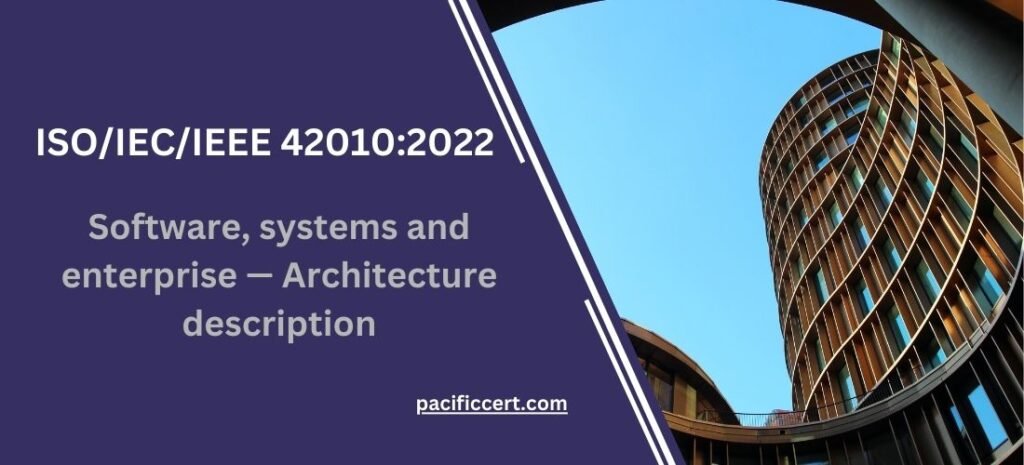
What is ISO/IEC/IEEE 42010:2022-Software, systems and enterprise — Architecture description?
ISO/IEC/IEEE 42010:2022 provides guidelines and recommendations for describing and documenting the architecture of software, systems, and enterprises. It defines architecture as “the fundamental concepts or properties of a system in its environment embodied in its elements, relationships, and in the principles of its design and evolution.” The standard provides guidance on how to describe and document architecture in a way that is consistent, complete, and understandable.
Some of the key requirements include:
Architecture description: The standard requires that architecture be described in a consistent and understandable way, using appropriate diagrams, models, and other documentation.
Stakeholder needs and concerns: The standard requires that architecture take into account the needs and concerns of stakeholders. Including users, customers, operators, maintainers, and other interested parties.
Architecture viewpoints: The standard recommends the use of multiple viewpoints to describe architecture. Including conceptual, logical, and physical viewpoints.
Architecture frameworks: The standard recommends the use of architecture frameworks. Such as TOGAF, Zachman, and DoDAF, to guide the development of architecture descriptions.
Also, Architecture compliance: The standard recommends that architecture be evaluated for compliance with relevant standards, laws, regulations, and other requirements.
Therefore, ISO/IEC/IEEE 42010 provides a comprehensive framework for describing and documenting the architecture of software, systems, and enterprises, with a focus on ensuring that architecture is understandable, complete, and consistent.
Requirements of ISO/IEC/IEEE 42010:2022
Consistency and completeness: Architecture descriptions must be consistent, complete, and accurate. Also, should cover all relevant aspects of the system being described.
Stakeholder concerns: Architecture descriptions must take into account the concerns and needs of stakeholders. Including users, customers, operators, maintainers, and other interested parties.
Multiple viewpoints: Architecture descriptions must be developed from multiple viewpoints, which may include conceptual, logical, physical, and other perspectives.
Architecture frameworks: Architecture descriptions should be developed using appropriate architecture frameworks. Such as TOGAF, Zachman, or DoDAF.
Architecture documentation: Architecture descriptions must be documented in a way that is clear, concise, and understandable. Using appropriate diagrams, models, and other documentation.
Finally, Architecture evaluation: Architecture descriptions should be evaluated for compliance with relevant standards, laws, regulations, and other requirements.
Therefore, The standard is intended to ensure that architecture descriptions are developed in a structured and consistent manner, taking into account the needs and concerns of stakeholders. And are well-documented and evaluated for compliance with relevant requirements.
Benefits of ISO/IEC/IEEE 42010:2022
Standardized approach: The standard provides a standardized approach for describing and documenting architectures across different domains and industries. So, This makes it easier for stakeholders to understand and communicate about architecture concepts and components.
Consistency and completeness: The standard promotes consistency and completeness in architecture descriptions, which helps to ensure that all relevant aspects of a system are covered and that stakeholders’ concerns are addressed.
Multiple viewpoints: The standard emphasizes the use of multiple viewpoints to describe architecture, which helps to provide a more complete and accurate representation of the system being described.
Architecture frameworks: The standard recommends the use of architecture frameworks, which can help organizations to develop architectures in a structured and consistent way, and can provide a common language and set of concepts for architecture development.
Evaluation and improvement: The standard encourages the evaluation of architectures for compliance with relevant standards and requirements, which can help organizations to identify areas for improvement. Also, to ensure that their architectures are effective and efficient.
Therefore, ISO/IEC/IEEE 42010:2022 provides a framework for developing and documenting architectures in a consistent, complete, and well-structured manner, which can help organizations to improve the quality and effectiveness of their software, systems, and enterprise architectures.
Who needs ISO/IEC/IEEE 42010:2022-Software, systems and enterprise — Architecture description?
ISO/IEC/IEEE 42010:2022 is intended for anyone involved in the development, documentation, and evaluation of architectures for software, systems, and enterprises. This includes:
Architects: Individuals responsible for designing and documenting architectures for software, systems, and enterprises.
Developers: Individuals responsible for implementing and maintaining software, systems, and enterprises.
Managers: Individuals responsible for overseeing the development and maintenance of software, systems, and enterprises. Also, ensuring that architecture descriptions meet organizational goals and objectives.
Quality assurance professionals: Individuals responsible for evaluating software, systems, and enterprise architectures for compliance with relevant standards, laws, regulations, and other requirements.
Also, Researchers and educators: Individuals involved in researching and teaching architecture concepts and techniques.
ISO/IEC/IEEE 42010 is relevant for a wide range of industries and domains, including information technology, telecommunications, aerospace, defense, transportation, healthcare, finance, and many others. Moreover, It can be used by organizations of any size, from small startups to large multinational corporations.
Pacific Certifications is accredited by ABIS, click here to apply for ISO/IEC/IEEE 42010 or get in touch with us at +91-8595603096 or support@pacificcert.com
Read About: IEC 31010:2019-RISK MANAGEMENT









